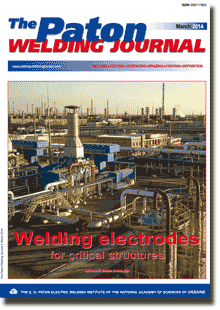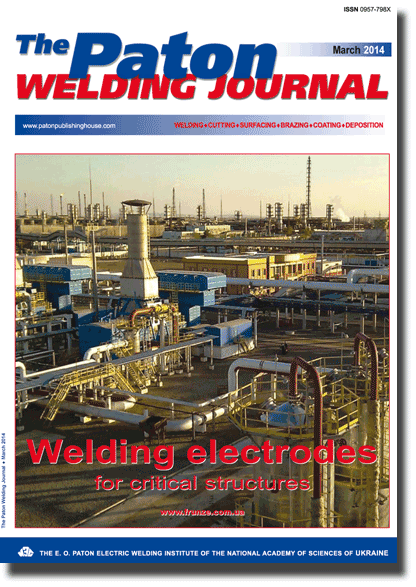
The Paton Welding Journal, 2014, #3, 16-20 pages
E.O. Paton Electric Welding Institute, NASU. 11 Bozhenko Str., 03680, Kiev, Ukraine. E-mail: office@paton.kiev.ua
Abstract
Magnesium alloys find ever wider application in different fields of industrial production, especially when products should have the lowest mass characteristics. Use of magnesium alloys for manufacture of such structures is the most challenging, but in this case, the technologies of their manufacture including also processes of welding using different methods, should be available and reliable. At the present time many specialists attribute the EBW to the category of high technologies. Firstly, the EBW process is carried out under the conditions of vacuum environment, which absolutely eliminates any oxidizing processes of liquid metal in weld pool. Moreover, during melting in vacuum the refining purification of molten metal from harmful impurities takes place, and strength characteristics of joints are the highest in this case. In the present work the results of experimental investigations of weldability of wrought magnesium alloys of different thicknesses produced using electron beam are given. The influence of the system of alloying and parameters of mode on formation of welds and sizes of penetration zone of billets of different thickness was shown. The strength characteristics of welded butt joints were determined. 8 Ref., 4 Tables, 6 Figures.
Keywords: electron beam welding, magnesium alloys, welding modes, strength of welded joints, microstructure of weld and base metal
Received: 10.07.13
Published: 28.03.14
References
1. (1978) Magnesium alloys: Refer. Book. Vol. 1: Metals science of magnesium and its alloys. Ed. by M.B. Altman, A.F. Belov, V.I. Dobatkin et al.; Vol.2: Technology of production and properties of castings and strained semi-products. Ed. by I.I. Guriev, M.V. Chukhrov. Moscow: Metallurgiya.
2. Rokhlin, L.L., Nikitina, N.I., Volchenkova, V.A. (2006) Examination of magnesium-enriched alloys Mg-Al2Cu. Metally, 2, 104-108.
3. Drits, M.E. (1964) Magnesium alloys for service at higher temperatures. Moscow: Nauka.
4. Vozdvizhensky, V.M., Grachev, V.A., Skassky, V.V. (1984) Cast alloys and technology of their melting in machine-building. Moscow: Mashinostroenie.
5. (1978) To problem of electron beam welding of magnesium alloys. In: Magnesium alloys. Moscow: Nauka.
6. Ejdenzon, M.A. (1974) Metallurgy of magnesium and other light metals. Moscow: Metallurgiya.
7. (1978) Magnesium alloys: Transact. of A.A. Baikov Institute of Metallurgy. Moscow: Nauka.
8. Bondarev, A.A., Nesterenkov, V.M. (2013) Study of weldability of magnesium alloy MA2 by electron beam in vacuum. Kompres. Energetich. Mashinostroenie, 2, 21-28.
AS = «Automatic Welding» - 6 issues per year;
TPWJ = «PATON WELDING JOURNAL» - 12 issues per year;
SEM = «Electrometallurgy Today» - 4 issues per year;
TDNK = «Technical Diagnostics and Non-Destructive Testing» - 4 issues per year.
| 2014 №03 (02) |
DOI of Article 10.15407/tpwj2014.03.03 |
2014 №03 (04) |

The Paton Welding Journal, 2014, #3, 16-20 pages
TECHNOLOGICAL PECULIARITIES OF WELDING OF WROUGHT MAGNESIUM ALLOYS BY ELECTRON BEAM IN VACUUM
A.A. BONDAREV and V.M. NESTERENKOV
E.O. Paton Electric Welding Institute, NASU. 11 Bozhenko Str., 03680, Kiev, Ukraine. E-mail: office@paton.kiev.ua
Abstract
Magnesium alloys find ever wider application in different fields of industrial production, especially when products should have the lowest mass characteristics. Use of magnesium alloys for manufacture of such structures is the most challenging, but in this case, the technologies of their manufacture including also processes of welding using different methods, should be available and reliable. At the present time many specialists attribute the EBW to the category of high technologies. Firstly, the EBW process is carried out under the conditions of vacuum environment, which absolutely eliminates any oxidizing processes of liquid metal in weld pool. Moreover, during melting in vacuum the refining purification of molten metal from harmful impurities takes place, and strength characteristics of joints are the highest in this case. In the present work the results of experimental investigations of weldability of wrought magnesium alloys of different thicknesses produced using electron beam are given. The influence of the system of alloying and parameters of mode on formation of welds and sizes of penetration zone of billets of different thickness was shown. The strength characteristics of welded butt joints were determined. 8 Ref., 4 Tables, 6 Figures.
Keywords: electron beam welding, magnesium alloys, welding modes, strength of welded joints, microstructure of weld and base metal
Received: 10.07.13
Published: 28.03.14
References
1. (1978) Magnesium alloys: Refer. Book. Vol. 1: Metals science of magnesium and its alloys. Ed. by M.B. Altman, A.F. Belov, V.I. Dobatkin et al.; Vol.2: Technology of production and properties of castings and strained semi-products. Ed. by I.I. Guriev, M.V. Chukhrov. Moscow: Metallurgiya.
2. Rokhlin, L.L., Nikitina, N.I., Volchenkova, V.A. (2006) Examination of magnesium-enriched alloys Mg-Al2Cu. Metally, 2, 104-108.
3. Drits, M.E. (1964) Magnesium alloys for service at higher temperatures. Moscow: Nauka.
4. Vozdvizhensky, V.M., Grachev, V.A., Skassky, V.V. (1984) Cast alloys and technology of their melting in machine-building. Moscow: Mashinostroenie.
5. (1978) To problem of electron beam welding of magnesium alloys. In: Magnesium alloys. Moscow: Nauka.
6. Ejdenzon, M.A. (1974) Metallurgy of magnesium and other light metals. Moscow: Metallurgiya.
7. (1978) Magnesium alloys: Transact. of A.A. Baikov Institute of Metallurgy. Moscow: Nauka.
8. Bondarev, A.A., Nesterenkov, V.M. (2013) Study of weldability of magnesium alloy MA2 by electron beam in vacuum. Kompres. Energetich. Mashinostroenie, 2, 21-28.
The cost of subscription/purchase order journals or individual articles
| Journal/Currency | Annual Set | 1 issue printed |
1 issue |
one article |
| AS/UAH | 1800 UAH | 300 UAH | 300 UAH | 150 UAH |
| AS/USD | 192 $ | 32 $ | 26 $ | 16 $ |
| AS/EUR | 180 € | 30 € | 25 € | 15 € |
| TPWJ/UAH | 7200 UAH | 600 UAH | 600 UAH | 280 UAH |
| TPWJ/USD | 384 $ | 32 $ | 26 $ | 16 $ |
| TPWJ/EUR | 360 € | 30 € | 25 € | 15 € |
| SEM/UAH | 1200 UAH | 300 UAH | 300 UAH | 150 UAH |
| SEM/USD | 128 $ | 32 $ | 26 $ | 16 $ |
| SEM/EUR | 120 € | 30 € | 25 € | 15 € |
| TDNK/UAH | 1200 UAH | 300 UAH | 300 UAH | 150 UAH |
| TDNK/USD | 128 $ | 32 $ | 26 $ | 16 $ |
| TDNK/EUR | 120 € | 30 € | 25 € | 15 € |
AS = «Automatic Welding» - 6 issues per year;
TPWJ = «PATON WELDING JOURNAL» - 12 issues per year;
SEM = «Electrometallurgy Today» - 4 issues per year;
TDNK = «Technical Diagnostics and Non-Destructive Testing» - 4 issues per year.

